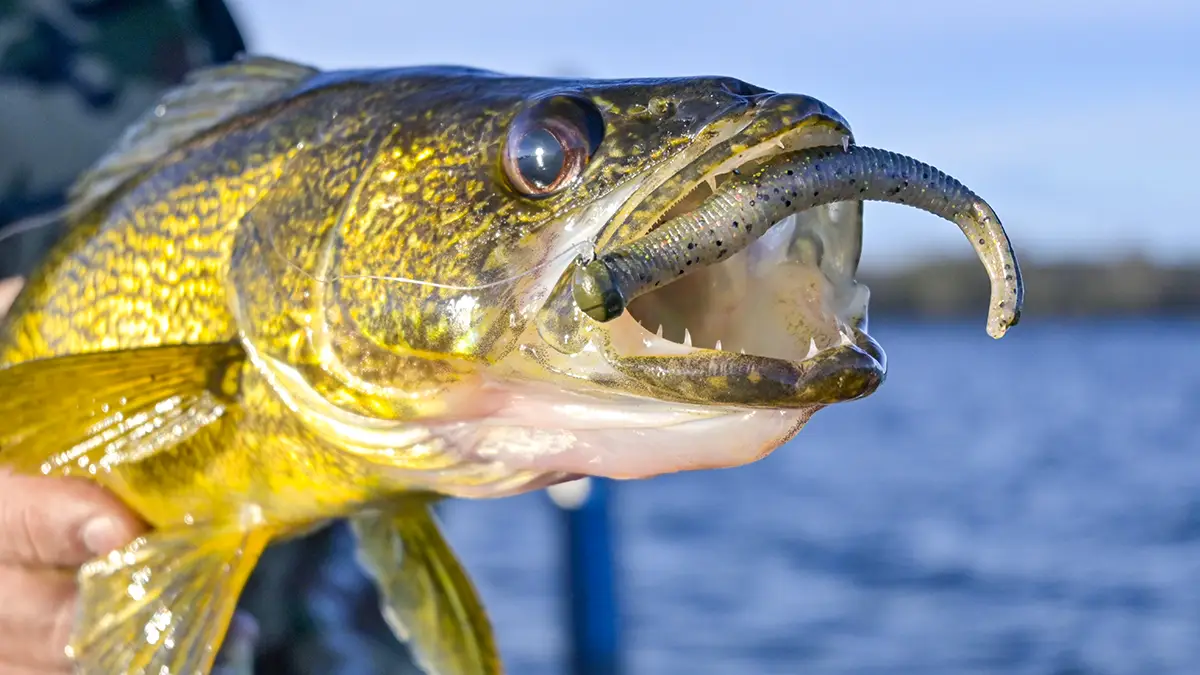Warning: Undefined variable $k in /home/nginx/domains/wired2fishcom.bigscoots-staging.com/public/wp-content/themes/understrap-child-0.6.0/functions.php on line 984
Warning: Undefined variable $k in /home/nginx/domains/wired2fishcom.bigscoots-staging.com/public/wp-content/themes/understrap-child-0.6.0/functions.php on line 987
Discussing the best walleye lures requires diving into a diverse range of baits since this species can be caught using a variety of jigging, casting, trolling and live bait rigging techniques. This guide is organized into several popular walleye bait categories (e.g., swimbaits, crankbaits).
Each section explains why these baits are effective and shares tips on using them to catch walleye. The content below is based on my personal experience fishing for walleye predominantly in Ontario, but also draws on insights gathered from fishing and talking with dozens of North American walleye fishing guides and professional anglers over two decades as an outdoor writer.
Whether you’re just getting into walleye fishing or are looking for a refresher on must-have walleye baits, we hope this guide serves as a useful resource for you. Our intent is to update it on a regular basis and update bait recommendation as we gain experience with different lures and new products come to market.
A Preamble on Jigs
Every year countless walleye are caught on jig presentations. But here’s the thing, few walleye jigs are appealing for walleye on their own, and require the addition of live bait or a soft bait to give the presentation an alluring profile, action, color, scent and taste. While this article’s focus here is on walleye “baits,” the importance of jigs cannot be ignored, so a few words are in order.
There are a lot of different styles of jigs available. Ball head jigs are the ones a lot of us started out using. These round headed jigs are very versatile and some of the most affordable.
Speciality jigs are also important to own, too. As examples, the added flash and vibration from a spin jig’s blade can catch you more fish when jigging soft or live bait, and jigs made to glide are deadly when fished with a snap jigging retrieve.
The headline here is jigs are essentials for a lot of walleye techniques. Having a collection of different weights lets you fish various depths and experiment with fall rate. Jigs between 1/8- to 3/8- ounces work in a lot of situations, but you may also want some lighter jigs for dangling live bait below a slip float and jigs 1/2-ounces or heavier for big swimbaits or when vertically jigging fast rivers.
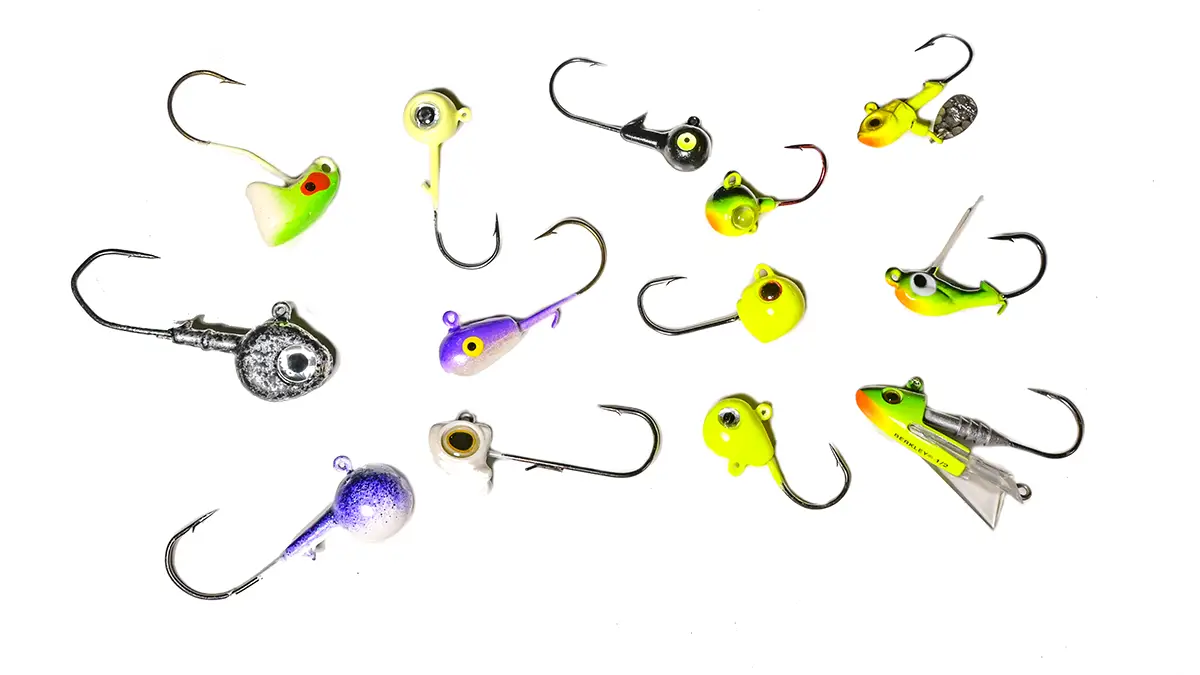
Best Walleye Jigs
- B-Fish-N H2O Precision Jig
- Berkley Fusion19 Snap Jig
- Freedom Zodiac
- Kalin’s Google Eye Live Bait Jig
- Northland Thumper Jig
- Northland Fire-Ball Jig
- Northland Weed-Weasel
- VMC Hammer Head Jig
- VMC Neon Moon Eye Jig
- VMC Hover Jig
- Z-Man ChatterBait WillowVibe
- Z-Man Finesse EyeZ Jigheads
Best Live baits for Walleye
Minnows, leeches and night crawlers are popular live bait options for jigging and rigging, and there are times when it’s tough to beat using the Real McCoy for walleye. Here’s a closer look at each of these critters.
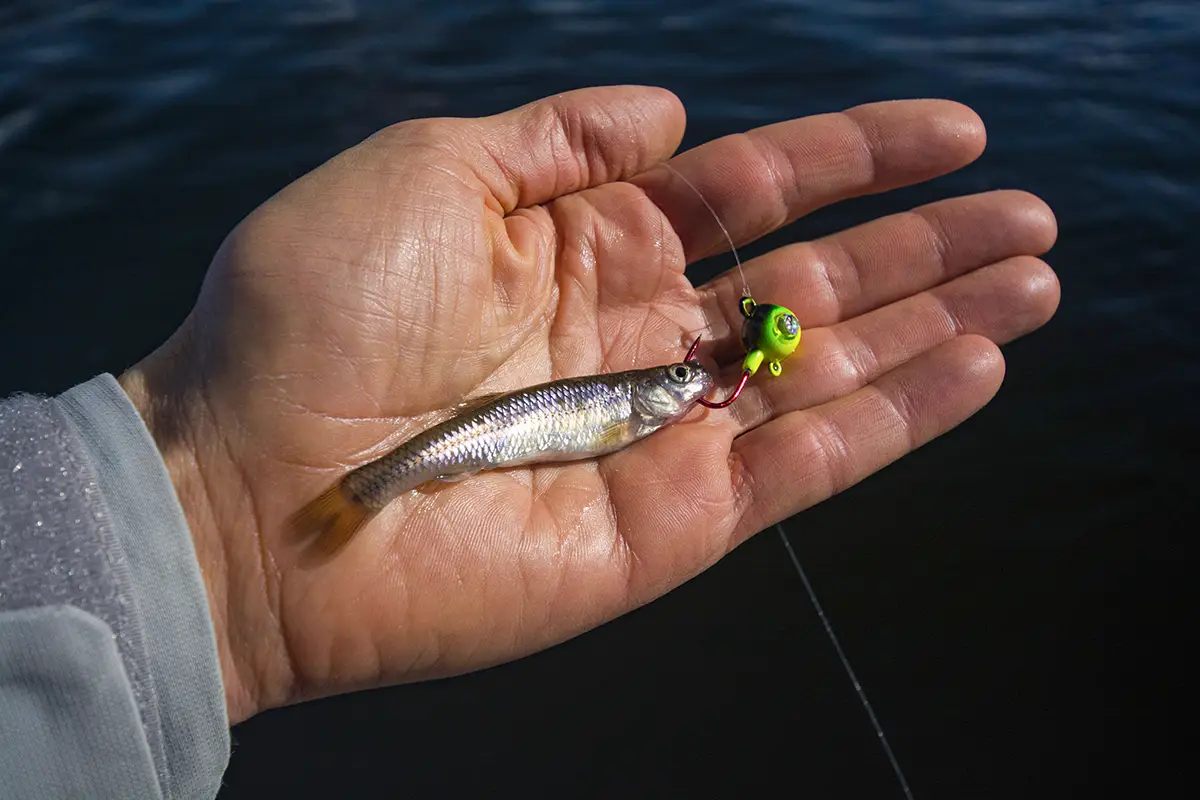
Minnows
One of the best walleye presentations of all time is a jig and minnow. For instance, fishing a shiner on a jig is a reliable way to put walleye in the boat in spring. Minnows are great on spinner rigs in spring and summer. Come fall, a lot of big walleye succumb to a big chub pulled along bottom on a Lindy or sliding egg sinker rig.
Leeches
The sight of an undulating leech is irresistible to walleye. Leeches work great on jigs, rigs and spinners. A leech dangling under a slip float and soaking in a fish’s face has long been a reliable way to finesse walleye.
Leeches work best from late spring to early fall when the water is warm enough for them to be active swimmers. Leeches ball up in cold water, rendering them unappealing to fish.
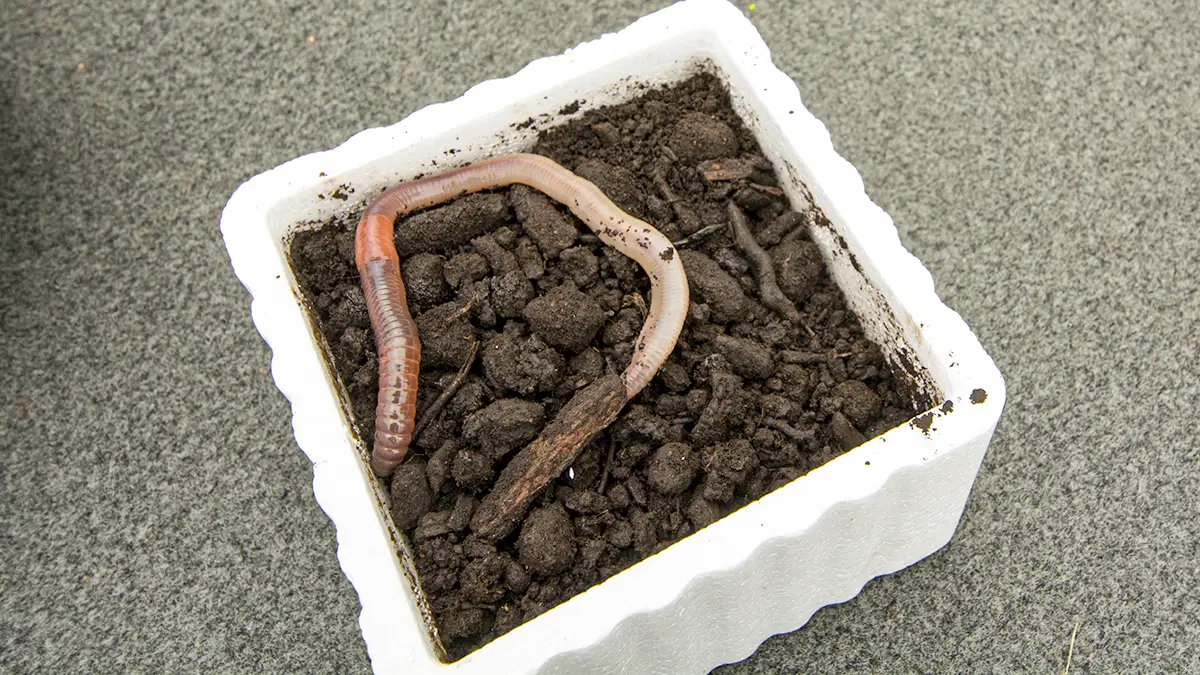
Night crawlers
One of the best summertime walleye techniques is trolling a worm harness rigged with a juicy night crawler. The presentation works behind a bottom bouncer for fish hugging the floor as well as behind an inline weight to catch walleye suspending in open water. A piece of fresh crawler on a slow death style hook corkscrewing on a lead of 8-pound mono behind a bottom bouncer is another excellent presentation.
Fishing a whole or half of a night crawler on a jig is also effective. Fishing worms on Lindy rigs has also put a lot of fish in my boat over the years.
Tip: Tipping a soft-plastic with a minnow, leech or piece of worm can be the best of both worlds, and catch you more fish.
Best Artificial Lures for Walleye
Soft and hard artificial baits are both very popular for walleye. These baits are more durable than live bait, which allows anglers to fish them more aggressively. Artificial lures are also engineered to appeal to a walleye’s predatory senses and instincts. Here’s a look at the various artificials available, starting with soft baits.
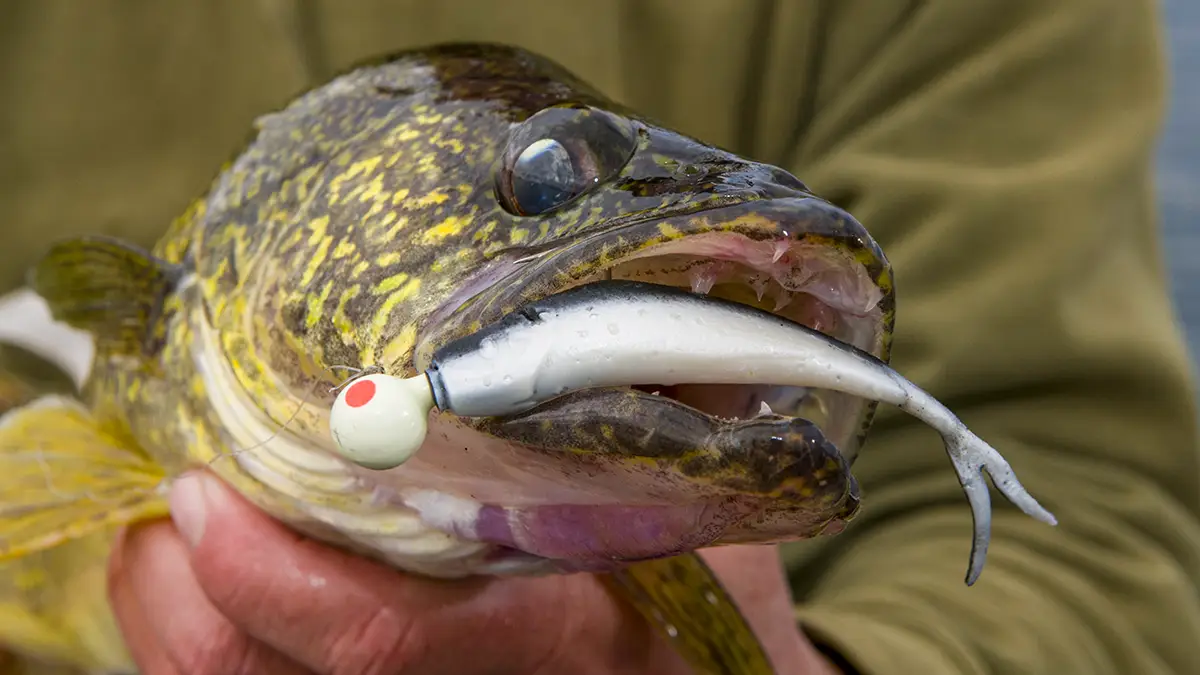
Minnows and soft jerkbaits
Being aggressive, opportunistic carnivores, it stands to reason baitfish shaped soft plastics rank high on the list of best walleye baits. We’re grouping minnow and soft jerkbaits together here because they tend to fish similar, share a common profile and usually have either forked, dolphin-style or finesse tails.
Generally, I stick with 2.5- to 4-inch baits in spring whether jigging or drop-shotting walleye. I’ve had some good days fishing 5.25-inch jerk shads on jigs in May and early June, but generally these baits see more action in autumn. Don’t rule out the power of downsizing though to coax bites throughout the season .
Tip: Minnows and soft jerkbaits need to be rigged straight on a jig. If crooked, they will favor one side and likely corkscrew with an unappealing action on the drop.
Recommended baits:
- Angler’s Choice Wally Min’R
- Berkley PowerBait MaxScent Flatnose Minnow
- Berkley PowerBait Minnow, or Buy at Berkley
- Berkley PowerBait Pro Twitchtail Minnow
- Lunker City Fin-S Fish
- Z-Man Scented Jerk ShadZ
- Z-Man StreakZ
- Zoom Fluke
- Zoom Super Fluke
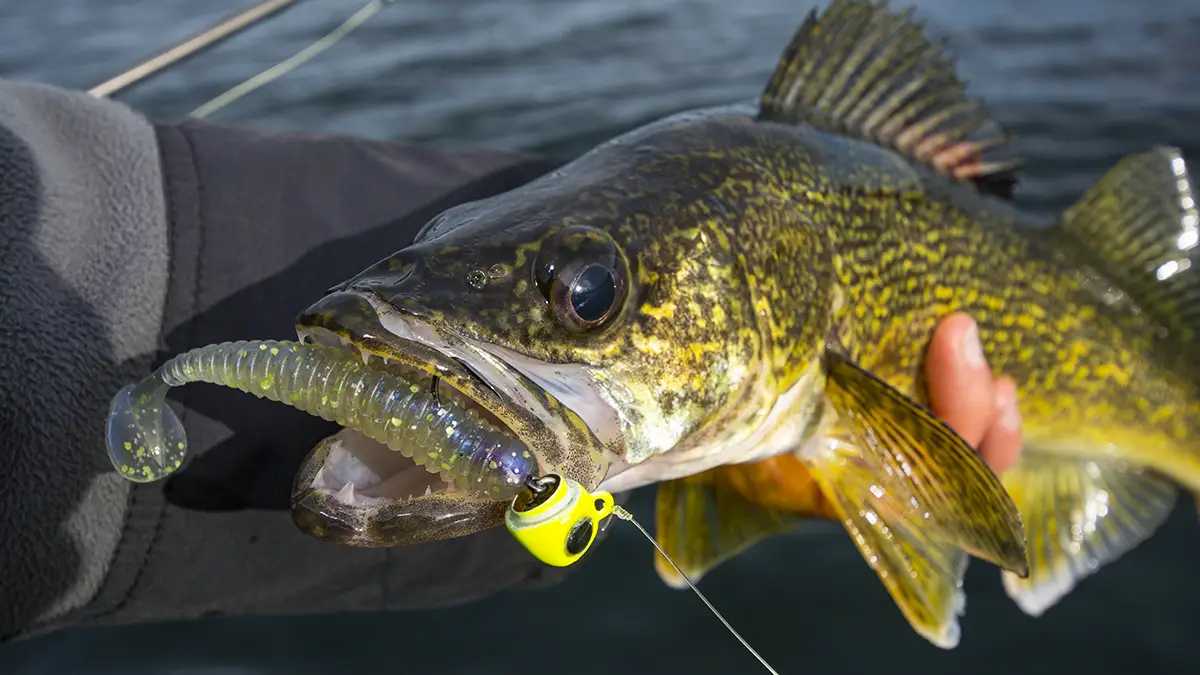
Swimbaits
Swimbaits are essential walleye baits and have paddle tails, which gives them their trademark kicking, swimming action and pronounced vibrations. Most swimbaits I use are made to fish on a jig, but I’ve caught plenty of walleye with internally weighted swimbaits over the years.
Slow roll a 3.5-, 3.8- or 4.5-inch swimbait along bottom when walleye are holding on flats, reefs, points and other structures and there’s good odds you’re going to get bites.
These lures can also be counted down to target suspending fish. Casting a small 2.5- to 3-inch finesse swimbait on a light jig is a good tactic for tempting fussy walleye in clear water.
Recommended baits:
- Berkley PowerBait Power Swimmer
- Jackall Rhythm Wave
- Keitech Fat Swing Impact
- Strike King Rage Swimmer
- Z-Man Slim SwimZ
- Z-Man Swimmin’ TroutTrick
- Zoom Swimmin’ Super Fluke Jr.
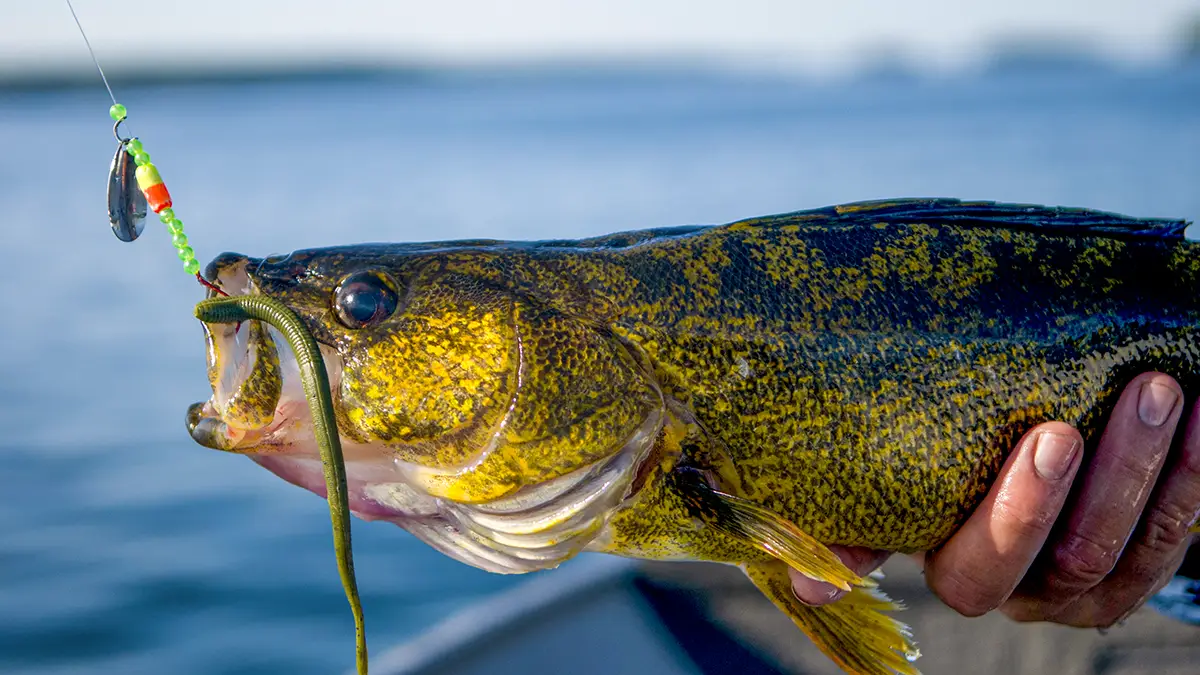
Worms
A variety of 3- to 6-inch worm soft baits can be used to fool walleye. Part of what makes these skinny baits so good is their undulating, quivering action.
Ring worms have ribbed bodies and small curly tails. Ring worms are versatile, but have a reputation of being particularly potent when fished on a jig during colder conditions in spring, fall and winter.
Jig worms between 3- to 4-inches are vertically jigging mainstays for many river walleye anglers. Popular worms in this category often have a flat, paddle tail or a tapered tail.
Thin, finesse worms are also worth owning. Drop-shotting a 3.5- to 4.5-inch version is a deadly technique in tough-bite scenarios. This set-up catches walleye fished vertically as well as cast and then shaken and dragged along bottom.
Scented artificial night crawlers are also good for walleye. Put one of these soft baits on a spinner rig or slow-death style hook and you’ve got a very durable and efficient presentation for trolling in a wide variety of scenarios. These soft baits are great for fishing vegetation and when walleye are mixed in with panfish, which are notorious for stealing live bait.
Recommended baits:
- Angler’s Choice Spear Tail Worm
- AuthentX Ringworm
- AuthentX Moxie
- Berkley PowerBait Rib Worm
- Berkley Gulp! Nightcrawler
- Roboworm Fat Straight Tail Worm
- Wyandotte Worm
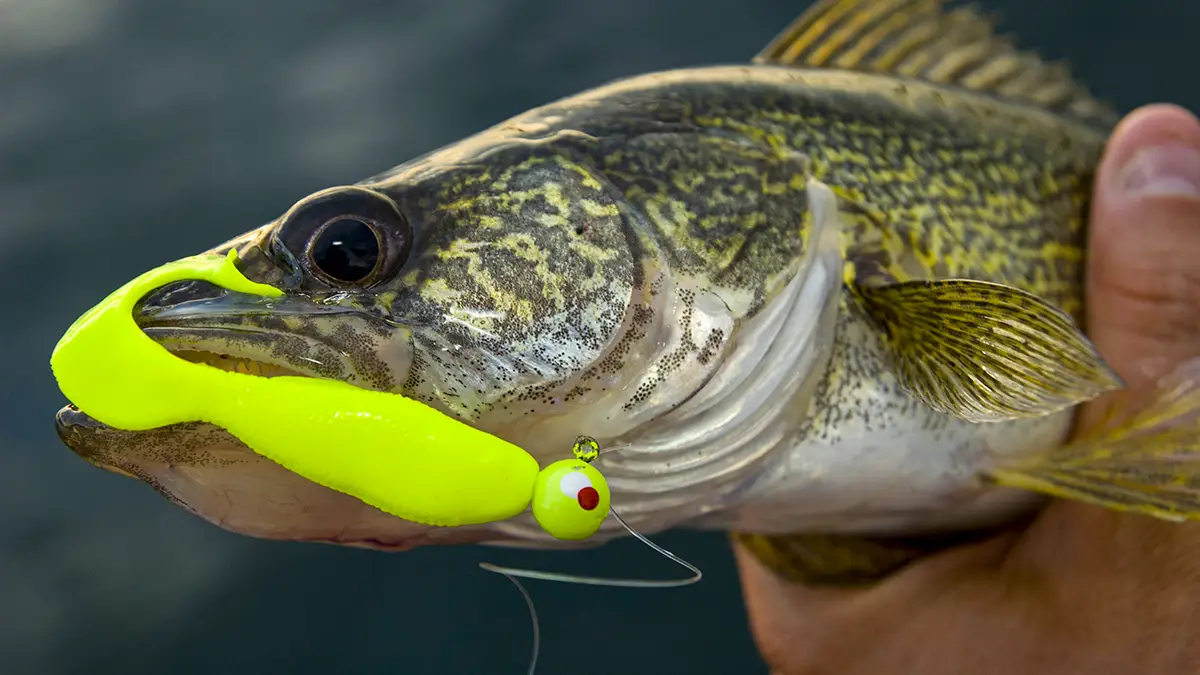
Grubs
When I was growing up, I caught a lot of river walleye from shore casting and jigging 3- and 4-inch chartreuse grubs. A jig and grub hopped along bottom or slowly reeled for a steady swimming action are two reliable ways to fish these baits to fool walleye with these soft baits. I don’t fish them as much these days, but they certainly deserve mention here.
Tip: It might look old-school, but adding a Jig Spinner wire form to a grub and jig combination is a great weed resistant presentation and worth trying when walleye are relating to vegetation.
Recommended baits:
- Berkley Gulp! Minnow Grub
- Mister Twister Meeny
- Mister Twister Twister Tail
- Northland Impulse Swim’N Grub
Ned rig
Walleye are opportunistic predators and given a chance they’ll gobble down crayfish, mayfly nymphs, and other edible snacks living on bottom. A green pumpkin or other earth-toned Ned rig shaken and dragged along a lake bed does a great job mimicking these critters.
Last fall, I marked walleye on a 32 foot hump using Garmin’s LiveScope forward-facing sonar. I then proceeded to throw a blade bait, a jig and plastic minnow, and swimbait with no luck. Then I tossed out a Ned rig and got bit. This is just one example of why I often have one of these baits ready on my deck.
There are a lot of Ned rig baits out there, but I’m partial to the buoyancy, action and durability of Z-Man’s ElaZtech material. Not to muddy the waters, but several of the small minnows and finesse worms mentioned above can be fished along bottom like a Ned rig.
Recommended baits:
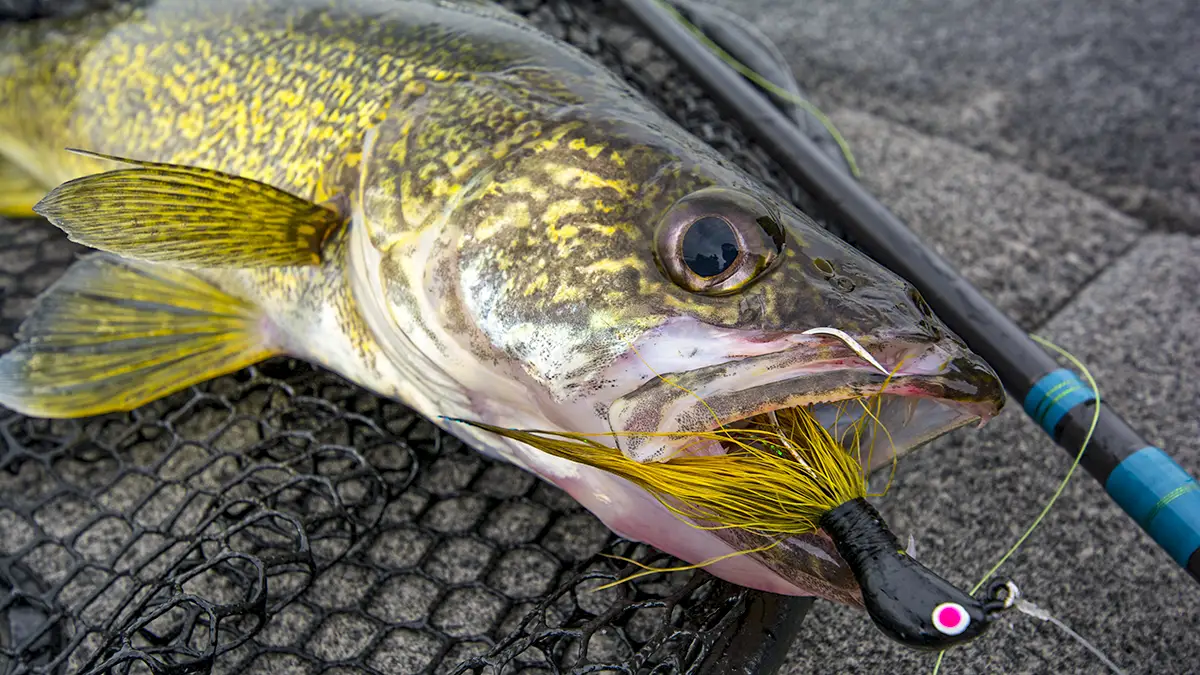
Bucktail jigs & other tied jigs
If I’m not exclusively trolling for walleye, 1/4- and 3/8-ounce bucktail jigs are mandatory in my boat. When walleye are relating to cabbage, coontail and other vegetation beds, aggressively rip-jigging a bucktail jig in the greenery and along the edges is a reliable tactic. The presentation’s commotion triggers reaction strikes, and a bucktail jig’s durablity means it can withstand the abuse of being torn through vegetation and being eaten by multiple walleye.
Bucktail, marabou and other tied jigs can also be fished less aggressively and make great finesse baits. Hopping a brown or olive version along bottom can mimic a crayfish, leech or nymph. Tipping a tied jig with a scented soft bait or live bait is a good strategy when you’re up against a tough bite.
Many of the bucktails I use I tie myself or are ones friends have made, but I’ve had good success with the jigs listed below.
Recommended baits:
- B-Fish-N Bucktail Wayne’s Bucktail Jig
- Challenger Bucktail Jig
- VMC Bucktail Jig
- VMC Hot Skirt Glow Jig
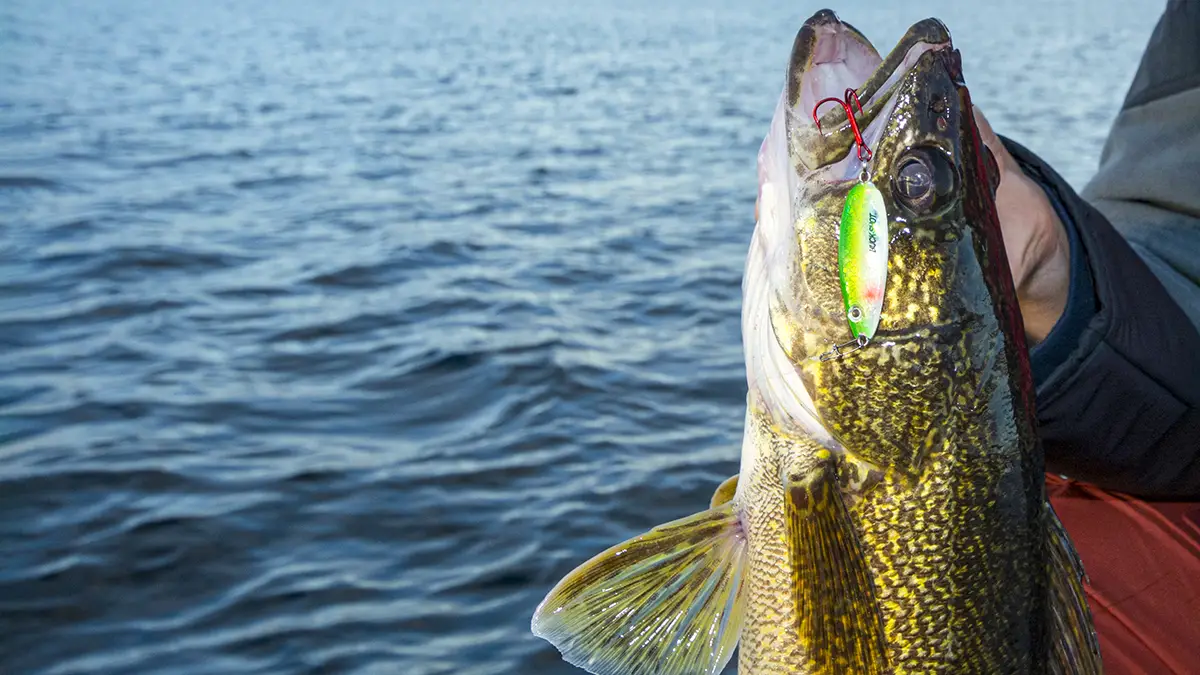
Jigging spoons
Jigging spoons have a reputation for being effective at triggering walleye in cooler water conditions, but these lures will also catch fish in summer. Spoons between 3/8- and 1/2-ounces see the most water time in my boat, but having some lighter and heavier models isn’t a bad idea.
A jigging spoon with a conservative falling action is an excellent tool for vertically jigging deep rocky humps, points, saddles, rock clusters on flats and current seams. Casting and then snapping a spoon back to the boat can also be quite effective and is a popular tactic among anglers using forward-facing sonar.
Recommended baits:
- Hopkins Smoothie
- Luhr-Jensen Cast Champ
- Northland Buck-Shot Rattle Spoon
- ReelBait Original Fergie
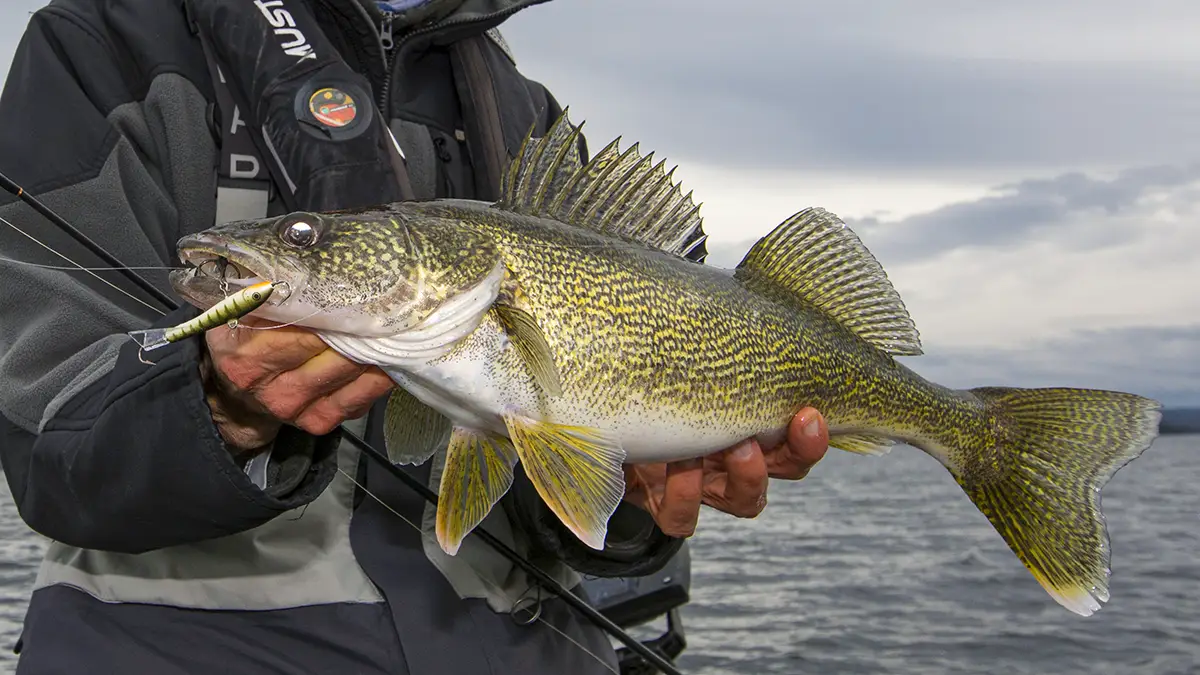
Gliding jigs
Casting, pitching and snap-trolling a #7 or a #9 Rapala Jigging Rap or another gliding jig is very popular these days, and Fishing Hall of Fame angler Al Lindner deserves a lot of credit for putting this technique on the map. Make no mistake, this is a power-fishing technique. These heavy baits cast far and sink fast, helping you cover water quickly. When snap-jigged aggressively, a gliding jig darts erratically, and can trigger reaction strikes from walleye.
With ice fishing in their DNA, it should come as no surprise that Jigging Raps and other gliding jigs are also fantastic for vertically jigging.
Recommended baits:
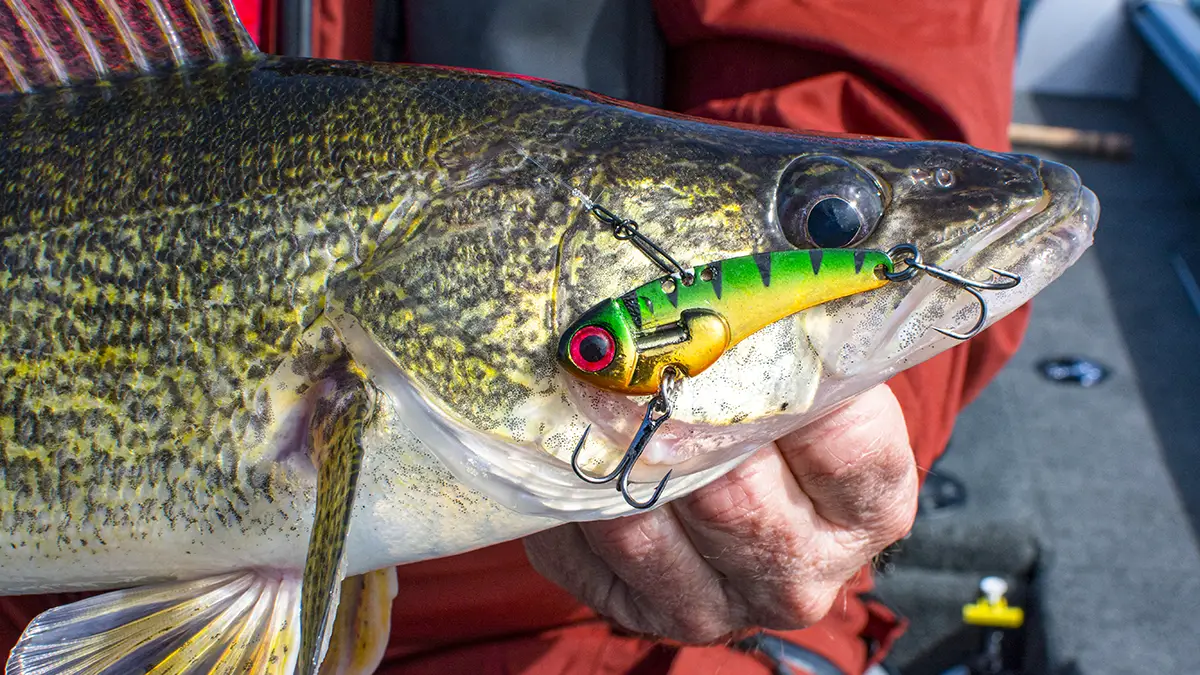
Blade baits
Blade baits are the final member of a potent trio of metal jigging lures for walleye. The vibration these lures produce really appeals to walleye in spring and fall, but don’t overlook them as an option for deep jigging in summer.
Whether casting or vertically jigging, it’s key to get the bait vibrating on the lift. Snapping a 1/2- and 3/4-ounce blade can trigger vicious strikes, but walleye can also be fooled with a subtle jigging approach with smaller, 1/4- or 3/8-ounce versions.
Recommended baits:
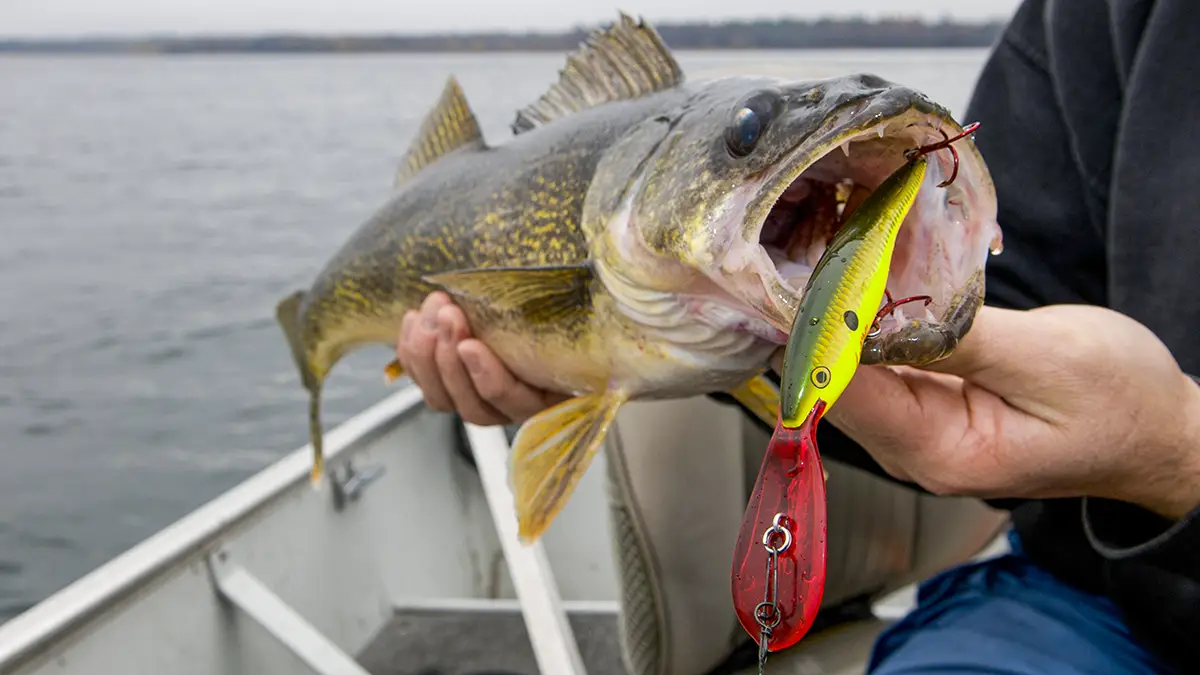
Crankbaits
Diving crankbaits are essentials, catching walleye from season opener to ice up. Trolled or cast, crankbaits fool walleye relating to weed edges, holding tight to structure, cruising flats, sitting in current breaks, and suspending and feeding on baitfish, to name just a few scenarios.
The “match the hatch” concept sees many anglers having good success using smaller crankbaits in spring and then progressing to larger lures in summer and the fall, but there can be exceptions to this rule, of course. A well rounded crankbait collection for walleye will include 2- to 5-1/2-inch lures in both shad and minnow profiles with varying running depths.
Shallow diving crankbaits are important tools for casting and trolling springtime walleye, or when fishing walleye at night from a boat or from the bank. When walleye hold deeper in the water column, as is often the case in summer and fall, trolling a crankbait capable of diving to 20 or 30+ feet is a reliable technique.
Crankbaits with a tighter action, like a Rapala Shad Rap, can be better in spring and autumn’s cold water, while cranks with a wider, more pronounced action can appeal more in warmer water. But, again, we’re talking in general terms here, and it’s always best to experiment and let the fish tell you what they like best.
Recommended baits:
- Bandit Walleye Deep Crankbait
- Bay Rat Long Deep and Extra Long Deep
- Berkley Flicker Shad
- Berkley Flicker Minnow
- Bomber Long A
- Rapala Shad Rap
- Rapala Original Floater
- Rapala Down Deep Husky Jerk
- Rapala Tail Dancers and Deep Tail Dancers
- Reef Runner Deep Diver
- Shimano World Crank
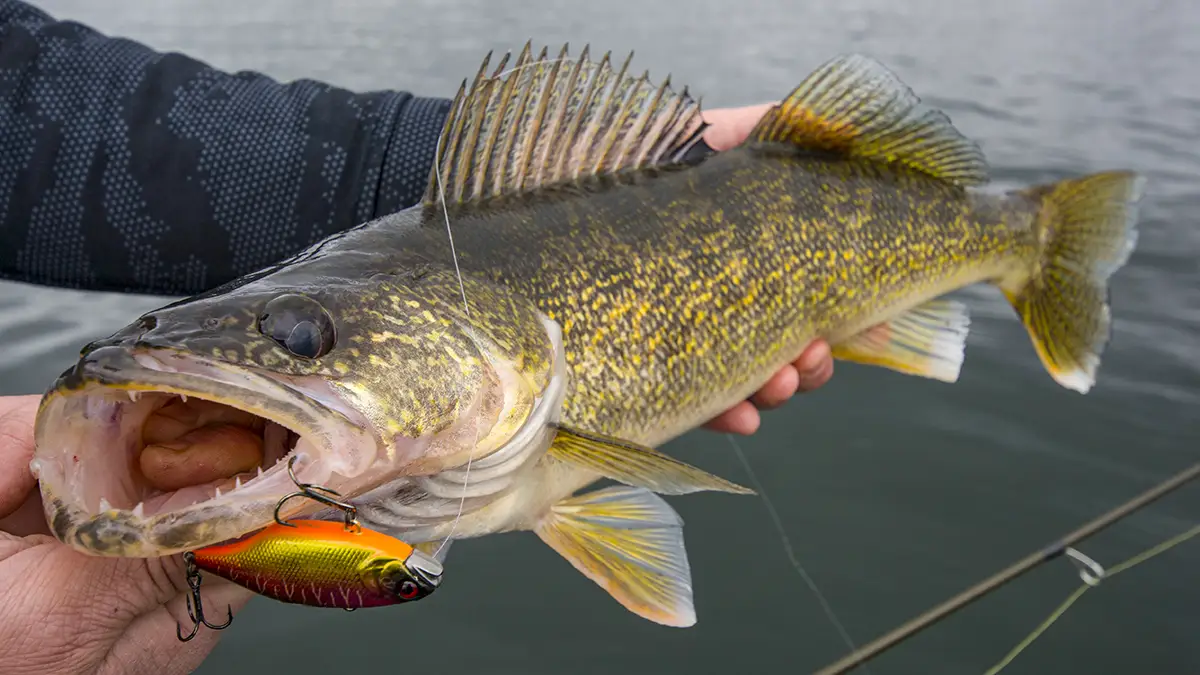
Lipless crankbaits
The heavy vibrations and rattles of lipless crankbaits make them popular picks among anglers wanting to cover water and appeal to aggressive walleye. These can be hopped along bottom similar to a blade bait. Yo-yoing these over the tops of grass or through lanes within vegetation can also be effective. Lipless cranks are excellent too when worked on a steady retrieve along bottom.
Recommended baits:
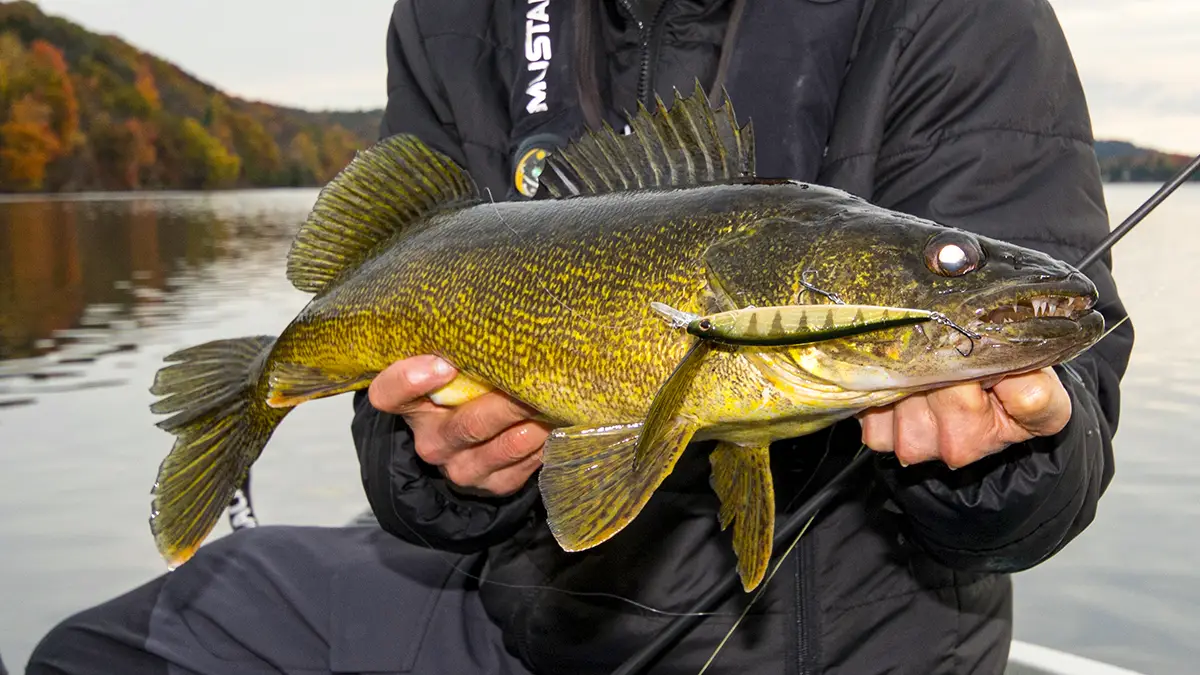
Jerkbaits
Walleye have a hard time resisting the sight of an erratically moving jerkbait that suddenly slams on the brakes and suspends for several seconds within striking distance. I’ve had great results catching walleye casting jerkbaits to points, shorelines, shallow flats and weed bed edges on windy and overcast, rainy days. When walleye are on mid-depth flats, a deep-diving jerkbait twitched through the feeding zone can be deadly.
Recommended baits:
- Berkley Stunna
- Megabass Vision OneTen+2
- Smithwick Suspending Rattlin’ Rogue
- Rapala Husky Jerk
- Rapala X-Rap
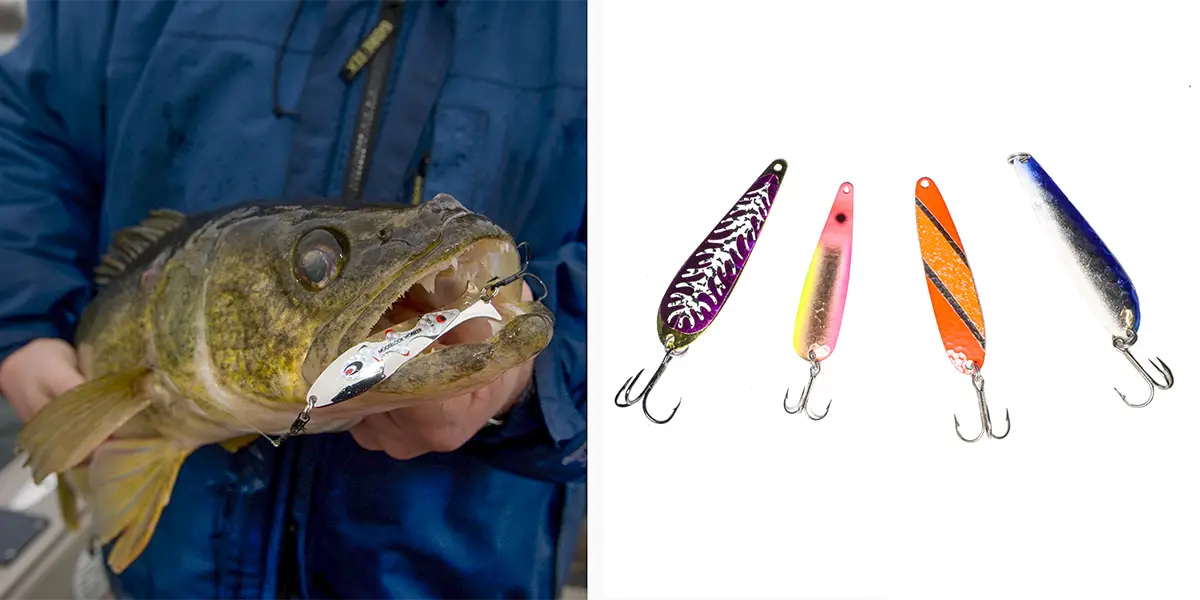
Trolling spoons
The flashy, wobbling action of 2.25- to 4-inch spoon can be very effective at attracting and triggering walleye feeding on shad, alewife, smelt and other baitfish. Trolling spoons behind planer boards, down riggers and dipsy divers is popular for walleye on the Great Lakes, but these methods can be applied on inland lakes as well.
Running spoons 2.5 to 3 miles-per-hour (sometimes faster) is an effective way to cover water.
This isn’t the only spoon trolling option, though. I’ve pulled light spoons at slower speeds using three-way rigs to catch walleye in summer and fall.
Recommended baits:
- Michigan Stingers
- Northern King NK-28
- Triple Threat Lures
- Mooselook Wobbler
- Williams Dartee
- Wolverine Tackle Mini Silver Streaks
- Wolverine Tackle Junior Silver Streaks
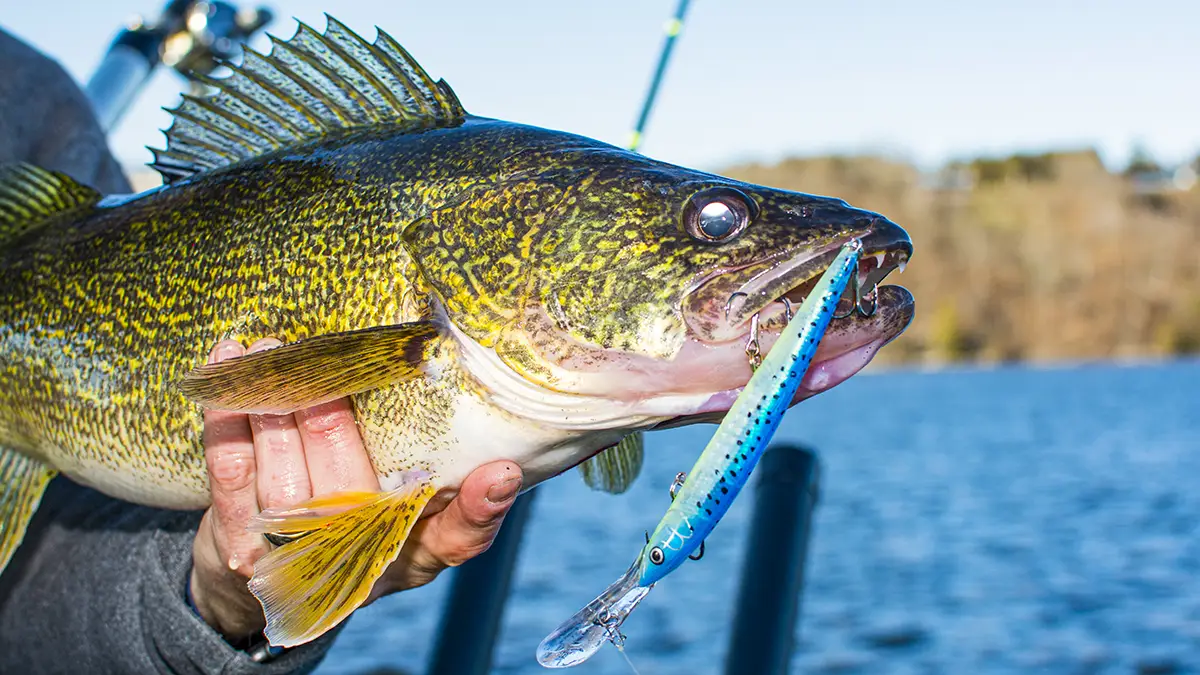
Best Colors for Walleye Baits
When it comes to walleye bait colors, you’ll want to carry a mix of natural and hot patterns. Perch, smelt, emerald shiner, alewife and other baitfish patterns tend to be good bets. Your collection should also include gold and silver metallic finishes.
Green, purple, orange, chartreuse and white/pearl are popular colors seen in many walleye baits. Glow patterns can also be good to have when fishing deep, dark water and at night. Olive, brown, black and minnow patterned bucktail jigs and Ned rigs have also served me well.
Fishing with a custom-painted bait is trending on the walleye scene. Many of these creations look like nothing you’d see in nature, but their effectiveness proves sometimes showing walleye a distinct presentation can make them strike.



